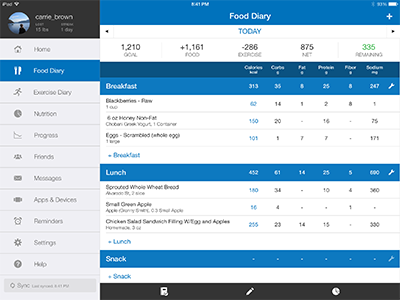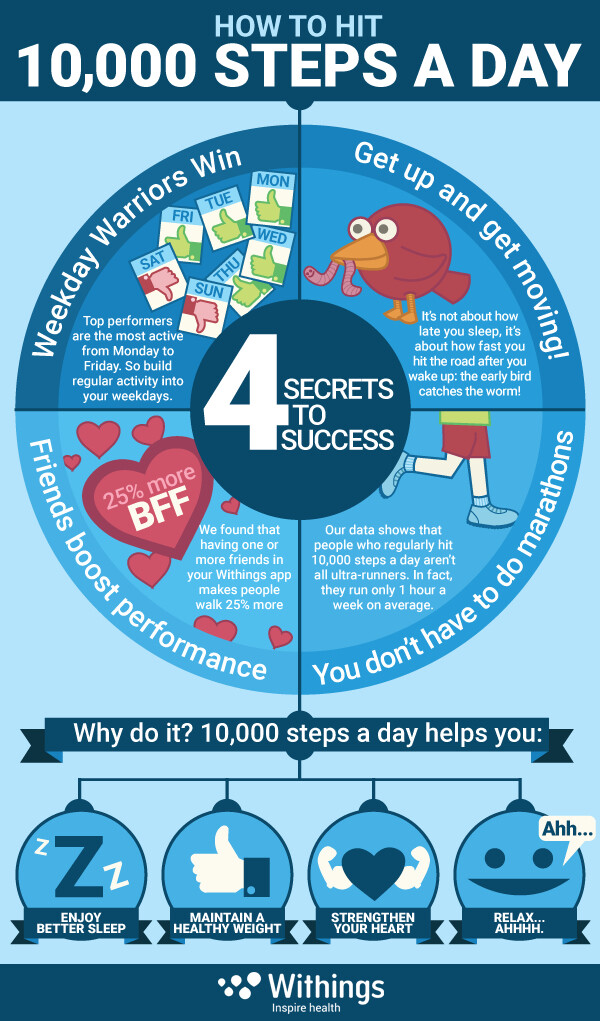The FitBit Effect : How Over-Reliance on Technology Could Be Sabotaging Your Goals
We are living in an Age of Technology, and before long every role we play as human beings may potentially be assumed by some form of robot or machine...
Nowhere have these advances been more prevalent than in the world of health and fitness. Sports science that was previously limited to elite athletes in the labs of the Soviet Union in the 80s has, over the last 15-20 years, been made accessible to the masses thanks to commercial developments by the Big Boys of Fitness (Under Armour, Strava, Apple, FitBit etc.).
At present, it seems that the world and his wife are now the proud owners of a FitBit, SmartWatch, or some crazy-clever mobile app that churns our countless physiological markets of health every single second!
Although this technological revolution has been incredibly successful in helping people stay accountable and motivated towards their fitness goals, I have started to notice that these gadgets have started to overstep into the realm of unhealthy obsession, compulsion, and behaviour that has a detrimental effect on one's physical and mental health.
I say this because, having suffered with anorexia during my teenage years, I myself have lived under the rule of fitness trackers and can personally testify to the negative impacts that technology can have on every element of your wellbeing!
In the article that follows, I am going to try and explain the warning signs of over-reliance on this technology, why they may have a negative impact on your lifestyle, and how to control the use of your devices in order to optimise and improve your health and fitness in a way that isn’t psychologically damaging.
**DISCLAIMER**
Before we get into the meat and veg of this article, I want to make one thing very clear: I am NOT criticising the use of activity trackers and other technologies to help you measure you, your training, and your nutrition. I merely wish to express the problems that arise when these helpful tools play a more dictatorial role within your daily routine, to a point at which it becomes unbearable...
WHY DO PEOPLE USE FITNESS TECHNOLOGY?
Many fitness fanatics are driven by numbers, whether that’s reducing the time taken to run a 10k, increasing your deadlift 3RM, or slashing your body fat percentage in order to look more defined.
Therefore, as sports science has become cheaper and more readily available for the Average Joe, it’s not really surprising that it has been embraced by the wider fitness community. Now, there are entire groups online based around applications/softwares that measure and compare daily performances in any given exercise.

The best example is Strava, one of the most successful mobile running applications out there, and an absolute pioneer in the field of the online fitness communities. Strava allows you to measure pace (min/km), speed (km/h), and distance (km), amongst other metrics, for running workouts both outside and on the treadmill.
After each session, you can analyse and compare your own performance to that of your previous workouts. Then, should you wish to share your daily achievements with friends/fellow runners, you can be placed on a ladder within your local area against other users. From there you can earn badges such as “furthest weekly distance run”, “fastest 5k”, or “longest unbroken run” according to the performance of others near to where you live.
Furthermore, one of the fastest growing types of software used in people’s quest for optimal health is macronutrient tracking applications that allows you to record everything that goes into the tank within seconds. MyFitnessPal, for example, is an incredibly user-friendly nutritional database that enables you to record the exact number of calories you consume over the course of a day.
And considering that very few people understand the calorie content of the foods they stick in the tank, this has certainly proved a game changer in encouraging people to adhere to their daily calorie target tailored to their individual goals.
THE FINE LINE BETWEEN MOTIVATION & OBSESSION
As previously noted, people like numbers, particularly when it comes to fitness. Objective figures allow us to effectively see progress over time, thus serving to motivate one towards their ideal self.
Yet there definitely comes a point when the motivation you feel to, say, achieve 10k steps per day, becomes an unhealthy obsession. What was once a useful indicator of daily activity levels may turn into an overwhelming, constant anxiety about being able to hit that particular target.
There comes a point where your FitBit-focused mindset becomes the sole determinant of your day: even though you may have caned a humongous shift in the gym and hit your daily calorie goal to within 20kcal of your target, the simple fact that your step counter shows 9,998 can mask your daily progress in a fog of negativity.
The solution? Keep it light and breezy! Do NOT stress yourself out if you fail to hit your daily step target. Instead, use it as a rough indicator as to how much you should be moving over the course of the day.
Furthermore, I am sure that, on some days, you will go miles over your target. Maybe on Sundays, you have the time to go for a wander with the family that will make up for the ‘lost steps’ on other days of the week when you are at work.
I find it is much less psychologically damaging to assess your daily levels of activity through your average daily step count over any given week; that way, you won’t find yourself stressing on a daily basis, as you take the week as a whole instead of 7 individual days.
DON’T PLACE FULL TRUST IN A MACHINE

Most phone applications, fitness trackers, and machine monitors usually like to emphasise one figure in particular: the number of calories burnt during any given exercise.
Unfortunately this single metric has led many down a path of disillusion, as the figure you see on your device/monitor is usually a hugely augmented number that causes people to overestimate their daily energy expenditure by a pretty hefty sum and compensate by eating more food that takes them out of a deficit and puts them into a calorie surplus.
In fact, according to an investigation by the BBC, the FitBit Charge 2 fitness watch overestimated the number of calories burned from walking by more than 50%!
Although this particular device proved more accurate when estimating the calories burned when running (+/- 4%), the fact remains that recreational walking is the most popular form of cardio in the UK, and therefore these inaccuracies will likely affect many people attempting to be more precise about their nutritional intake
The solution? When crunching the numbers for how much energy you expend over the course of a day, I find it is much more effective to use the traditional method of determining your daily calorie needs, whereby you multiply your BMR (number of calories burned at rest) by an activity factor depending on how active you are on a daily basis.

Additionally, remember to always take the number of calories burned on your treadmill/spin bike/fitness watch with a hefty pinch of salt!
THE TRAP OF A WORK-REWARD MINDSET
This one is closely linked to the overestimation of energy expenditure previously explained.
Have you ever eaten a packet of crisps (or any other personal vice of yours), looked at the label, and then hop on an exercise bike until the ‘calories burned’ number on your FitBit reaches that of the food just eaten?
Or alternatively, have you ever jumped on the treadmill for an hour and looked to your Apple Watch for peace of mind that the takeaway pizza you are going to have later remains within your daily calorie goal?
Chances are, you probably concurred with one or t’other of the situations above; both of which convey a negative mindset whereby food is seen as a reward that has to be ‘worked for’.
This is known in the world of psychology as ‘extrinsic motivation’ , and has frequently been proven as a less effective mindset to employ for long term success. In the aforementioned instances, your fitness trackers only serve to give you affirmations that you have ‘earnt’ whatever food it is that’s your vice.
/2795384-differences-between-extrinsic-and-intrinsic-motivation-5ae76997c5542e0039088559.png)
The solution? Try and avoid the idea that food should be ‘earned’ or ‘worked off’; instead, use your fitness tracker to guide you towards determining a daily calorie target for your personal goals.
Then, if you want to have a meal out or a piece of cake every now and then, adjust your intake accordingly so that nutritional treats can remain as part of a healthy diet!
MAPPING YOUR MACROS
MyFitnessPal has changed the game on honing in on your nutrition game for whatever fitness goal you so desire. The easy-to-use software allows you to precisely record the number of calories you consume in a day, as well as the exact macro- and micronutrient breakdown of what you’re eating and drinking.
See Related : The Case of Calories

I use MFP all the time with my athletes, and I have very little criticism for the app itself. The only thing I would be cautious with when it comes to using nutritional tracking technology concerns your individual psychology towards food and eating.
What I mean is that, for a select few, consistently tracking food intake in this way may lead to negative thought patterns towards your food.
Starting as a venture into a healthier lifestyle, it is very easy to steadily fall into a narrow mindset that strips any form of enjoyment or satisfaction from the act of eating, and replaces this with an intense focus solely on the nutritional value of different foods and meals.
To put it frankly, when tracking your macros becomes an obsession, it may be the early warning signs of an eating disorder. Take it from someone who fell into this exact trap...
See Related : Downloads ==> Guide to MyFitnessPal
The Solution? Most people are more than capable of tracking the macros using apps like MFP without any sign of negative thinking patterns; indeed, I actively encourage many of my clients to get on the Tracking Wagon as it is a great way to stay accountable to your nutrition.
Just be aware of when healthy habits turn into obsessive compulsions; when it gets to that stage, it may be time to turn to a more habit based approach.
THE FINAL WORD
Technology definitely has its place in a healthy lifestyle, and devices such as fitness trackers can play a central role in motivation, persistence, and accountability to a training and nutrition programme.
However, with the great power of what we now hold at our fingertips (in terms of fitness gadgets and gizmos) comes the great responsibility that we have to ourselves; that is to keep moving in the right direction both physically and mentally towards our goal.
Don’t let your fitness tracker dictate your training ;
Don’t let your MFP food diary dictate your lifestyle;
And don't let the use of your fitness technology come at the expense of your attitude towards exercise and your mental wellbeing.Use these awesome tools for what they were intended for: to guide you in your quest to achieve your fitness goals.
Harry Gripper
If you have any questions or comments about the things discussed in this article, go ahead and drop us a line and I will try as best I can to help you out :)
JOIN THE DREAM TEAM
Become One of My Athletes
Change YOUR Life...
And Get A Grip On Your Health & Fitness!
Contact now at gripperpt@gmail.com,
or via Mobile at 07399 616822



